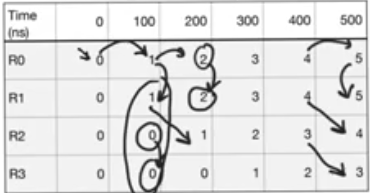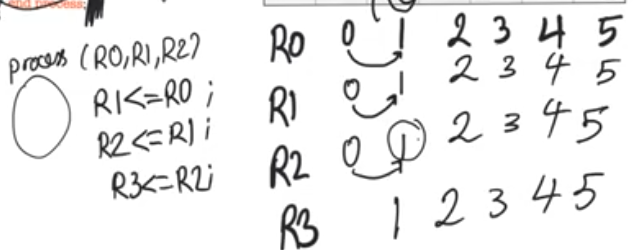process, transactions and events
source this playlist on VHDL design.
Process
- Process allows executing sequence of events so you can have memory elements
- Statements within processes execute in sequence.
- Their main use is to declare registers and latches and memories
- When the simulation starts, any process will execute at least once
- There are different ways to control how often a process is executed like sensitivity list and wait statement
Sensitivity list
- A sensitivity list is a list of signals that lie in the parenthesis after the process statement, it’s a list of signals that sensitize the process, cause the process to execute whenever they change, so a process will execute once after simulation starts, and not gonna execute again until a change happens on a signal of the sensitivity list
- In the example, R2 doesn’t take the current value of R1, it takes the previous value, because when R0 is assigned to R1 a transaction happened not an event
process_label: process(R0) -- R0 is in the sensitivity list
begin
R1 <= R0;
R2 <= R1;
R3 <= R2;
end process; -- change happens here

Transactions and events
- Event is an actual change in the value of the signal
- When the value of a signal changes, in a register, of a wire that’s an event
- Transaction is just a scheduling of an event, an intend to change the value of a signal
- Whenever you make a signal assignment in a process that causes a transaction not an event, so the value of the signal doesn’t change.
- A transaction turn into an event at the end of the process -for now-
- Updating transactions to events takes zero times, it takes a nominal delay which is delay that takes place within the simulator, it doesn’t take any real delay, it’s an artifact of the simulator but it’s necessary because without having a distinction between transactions and events you can’t have registers and latches
fully populated sensitivity list
- If the sensitivity list of the process is fully populated, having (R0, R1, R2), when R0 is changed, the process is called -with 0 delay- and an event happens on R1, so the process is called again immediately -with 0 delay- so the value of R1 will update with the value of R0 which hasn’t changed, and the value of R2 will update with the new value of R1, and a new event of R2 happens and the process is called again and this all happens with 0 delay
- So when we have a fully populated sensitivity list, the code within the process became compinational
- A process with a deficient sensitivity list will be used to declare registers, A process with a complete sensitivity list will be used to declare complicated combinational blocks like state machines.
